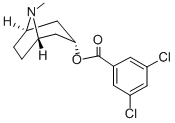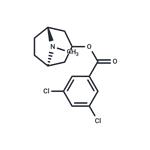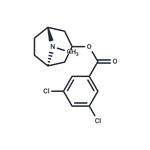It is most often used to study the role of SR-3. Studies suggest the blockade of SR-3 with may ameliorate beta-amyloid protein-induced neurotoxicity by interfering with the increase of Ca2+, and then by inhibiting glutamate release, generation of reactive oxygen species and caspase-3 activity. It is also used in the study of dopamine elevation in rats due to cocaine and amphetamine consumption.
Tropine (34.24 g) is treated with anhydrous diethyl ether and ethereal
hydrogen chloride and the precipitated hydrochloride is isolated by
evaporation of the solvent. 3,5-Dichlorobenzoylchloride (51.7 g) is added and
the mixture stirred at 140°C for 15 minutes during which time the mixture
liquifies, evolves hydrogen chloride gas and resolidifies. After heating for a
further 15 minutes the cooled solid is dissolved in water, an excess of an
aqueous solution of potassium carbonate is added, and the base is extracted
with ethyl acetate. Evaporation of the dried ethyl acetate solution yields a
solid, which is recrystallized from aqueous methanol to yield 3,5-
dichlorobenzoic acid 8-methyl-8-aza-bicyclo[3.2.1]oct-1-yl ester (endo). MP:
95°C (51.8 g).


